Abstract
The role of sensory reinforcement was examined in programming multiple treatment gains in self-stimulation and spontaneous play for developmentally disabled children. Two phases were planned. First, we attempted to identify reinforcers maintaining self-stimulation. Sensory Extinction procedures were implemented in which auditory, proprioceptive, or visual sensory consequences of self-stimulatory behavior were systematically removed and reintroduced in a reversal design. When self-stimulation was decreased or eliminated as a result of removing one of these sensory consequences, the functional sensory consequence was designated as a child's preferred sensory reinforcer. In Phase 2, we assessed whether children would play selectively with toys producing the preferred kind of sensory stimulation. The results showed the following. (1) Self-stimulatory behavior was found to be maintained by sensory reinforcement. When the sensory reinforcer was removed, self-stimulation extinguished. (2) The sensory reinforcers identified for self-stimulatory behavior also served as reinforcers for new, appropriate toy play. (3) The multiple treatment gains observed appeared to be relatively durable in the absence of external reinforcers for play or restraints on self-stimulation. These results illustrate one instance in which multiple behavior change may be programmed in a predictable, lawful fashion by using "natural communities of sensory reinforcement."
Full text
PDF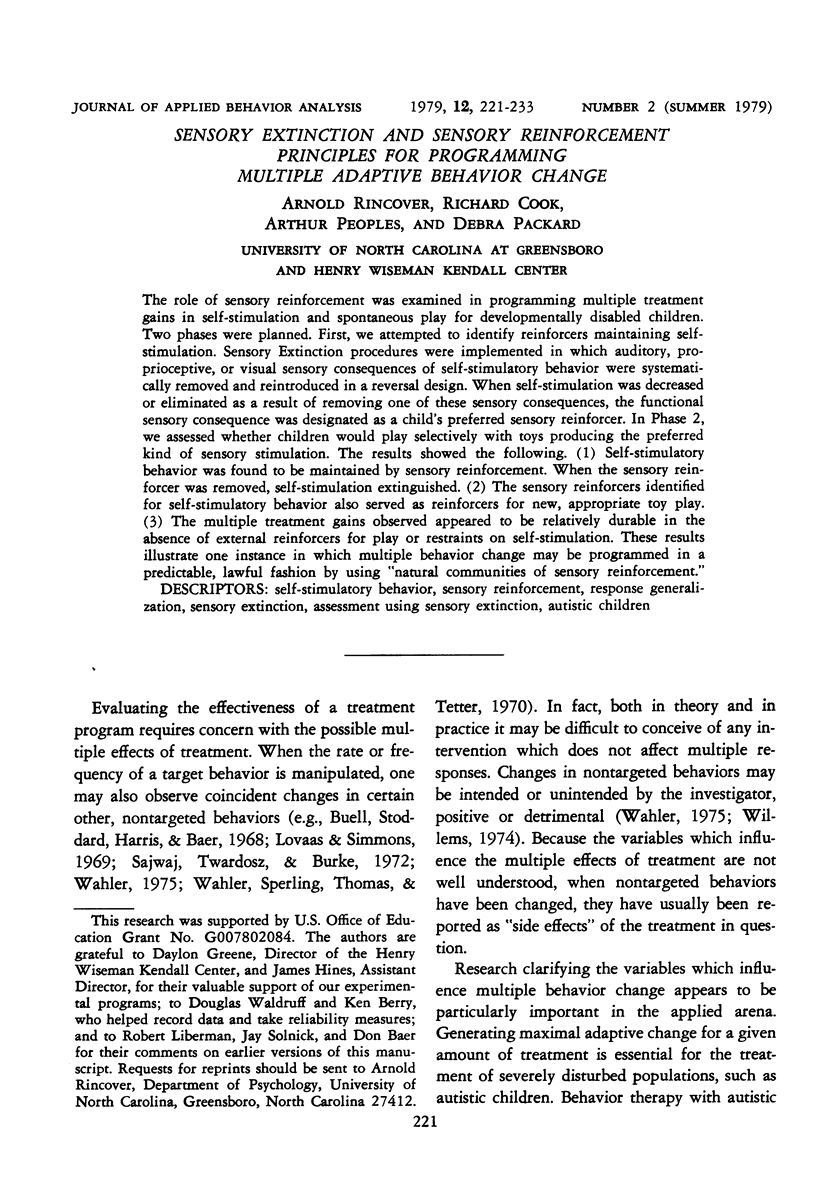
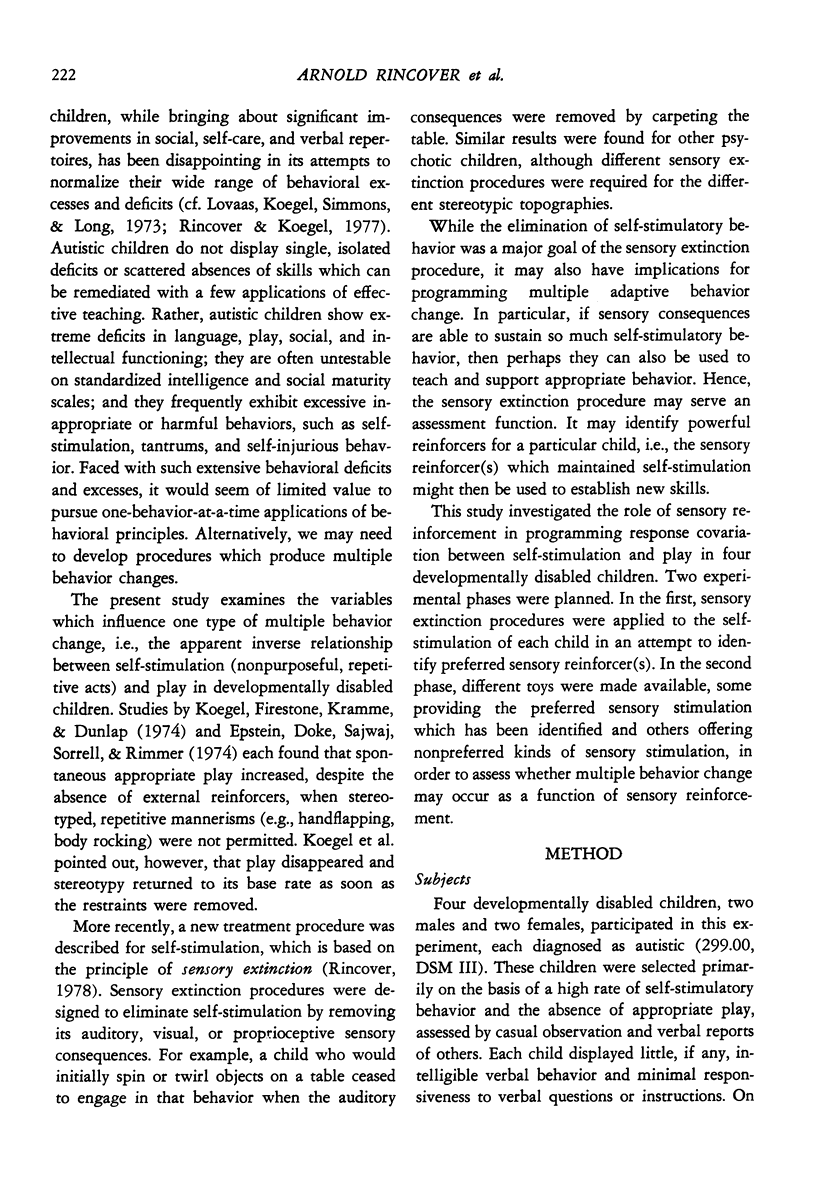
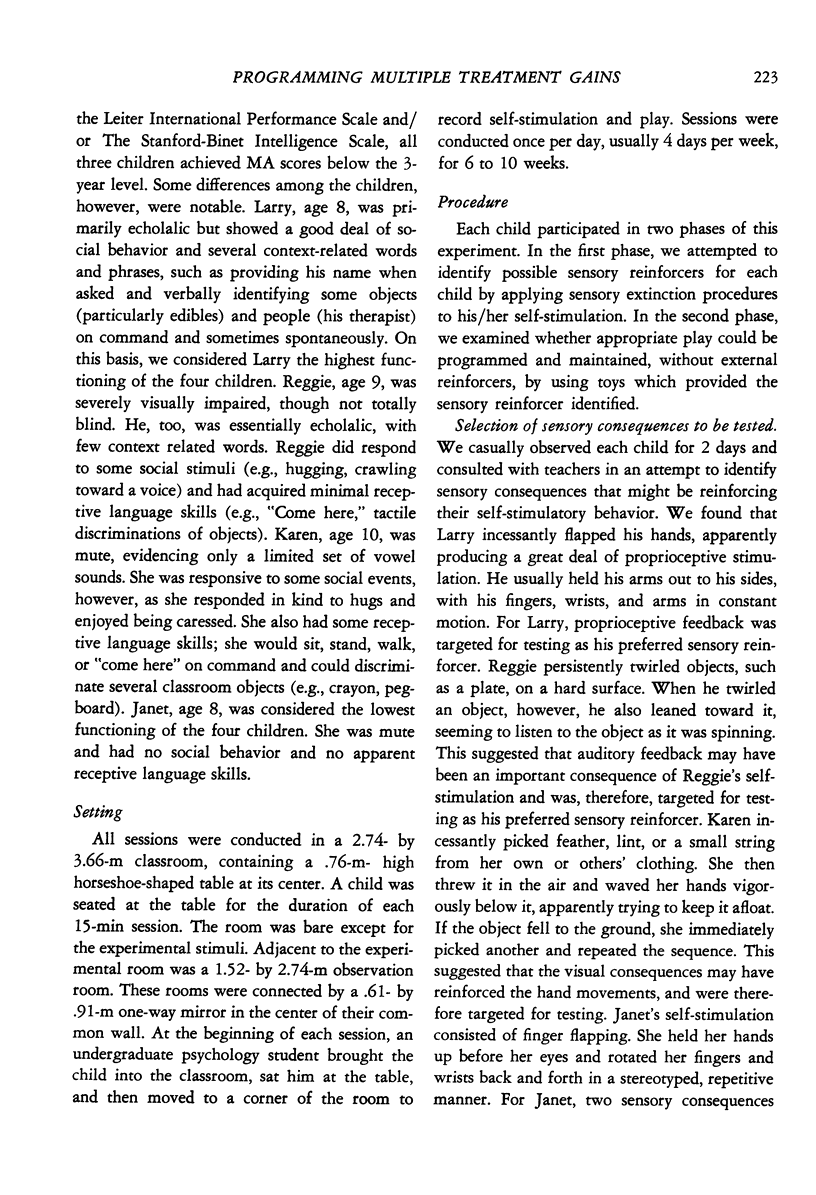
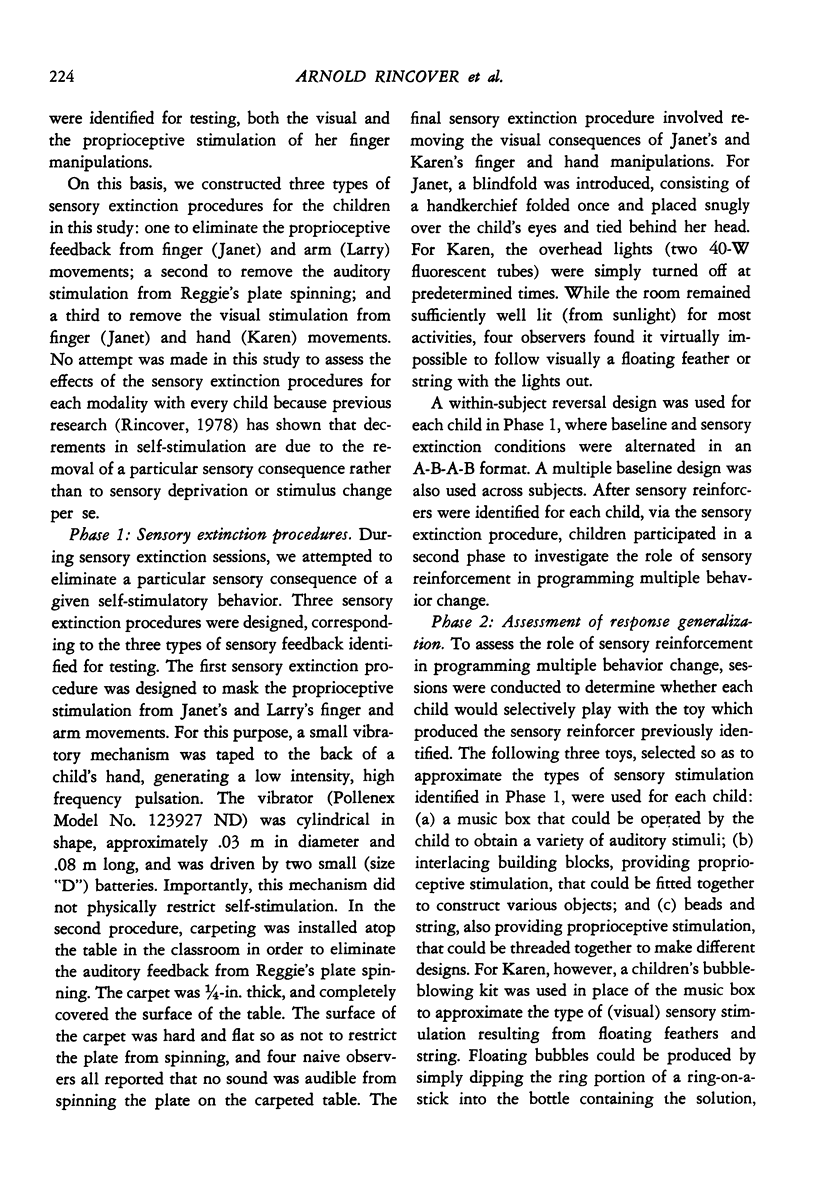
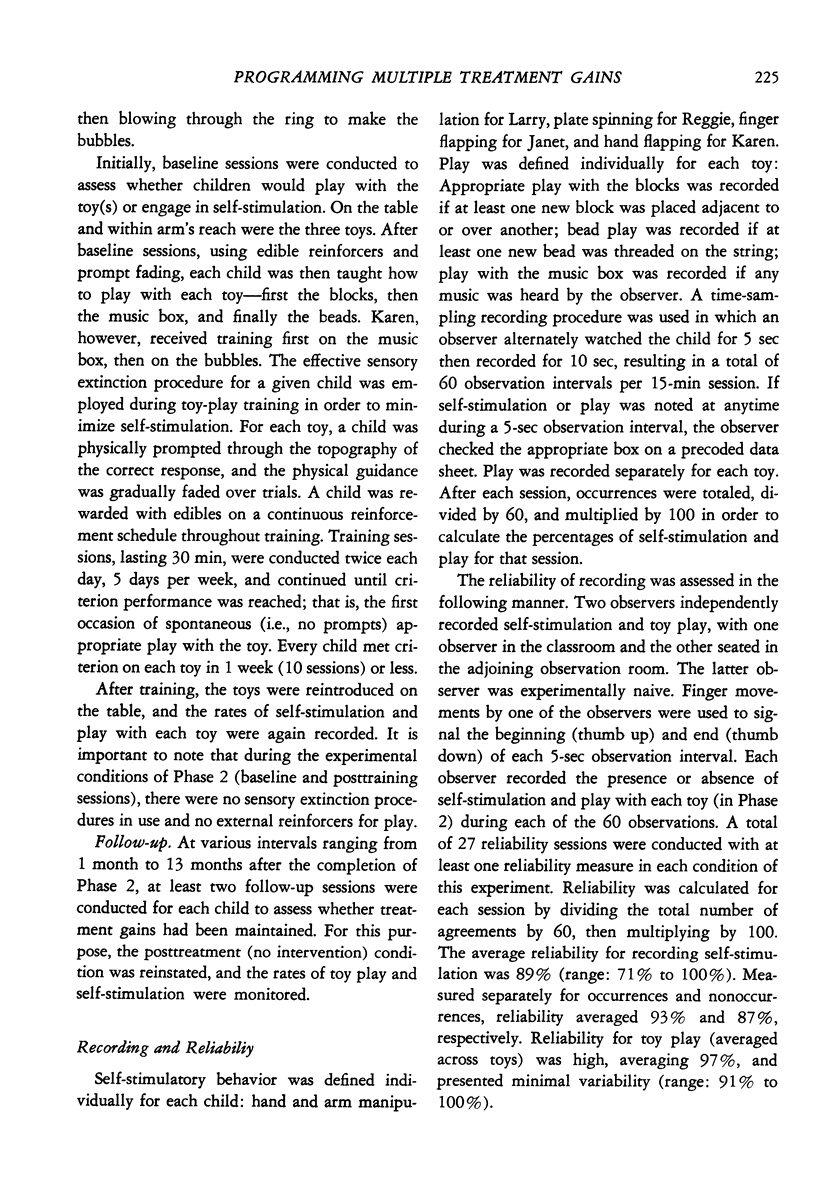
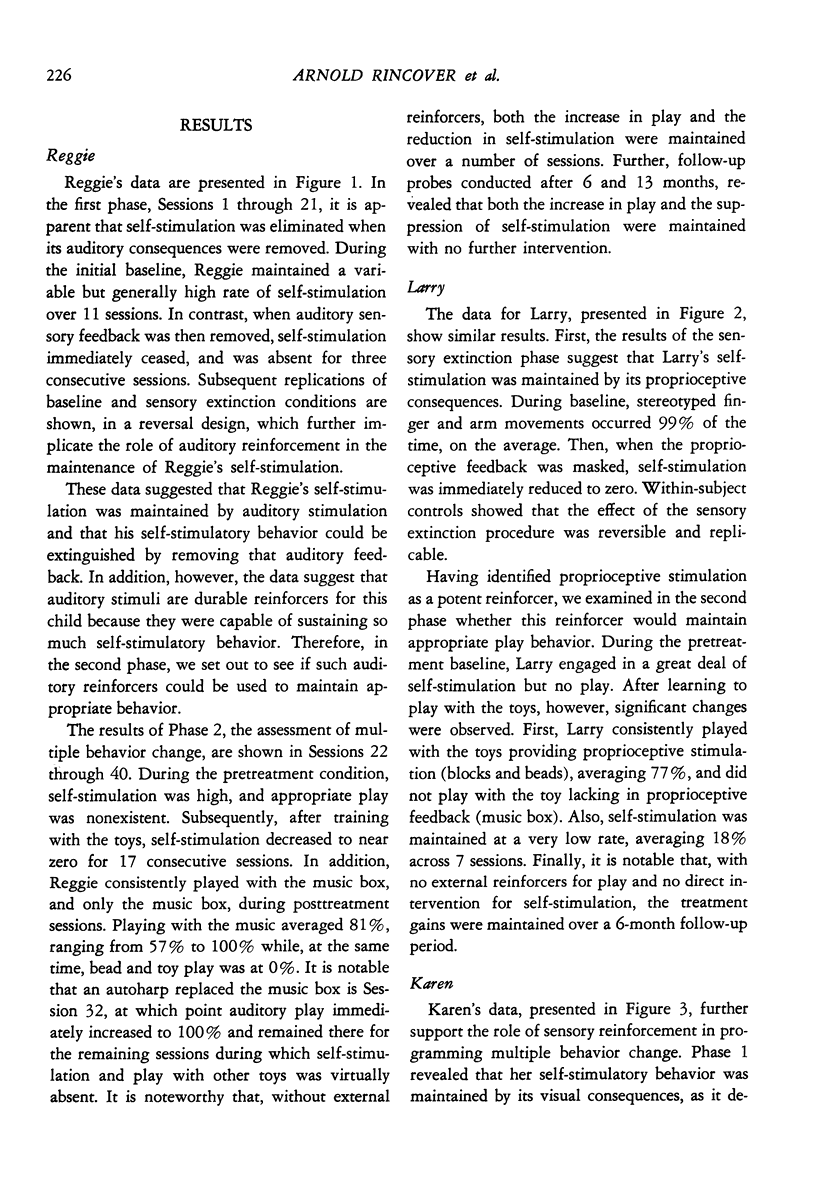

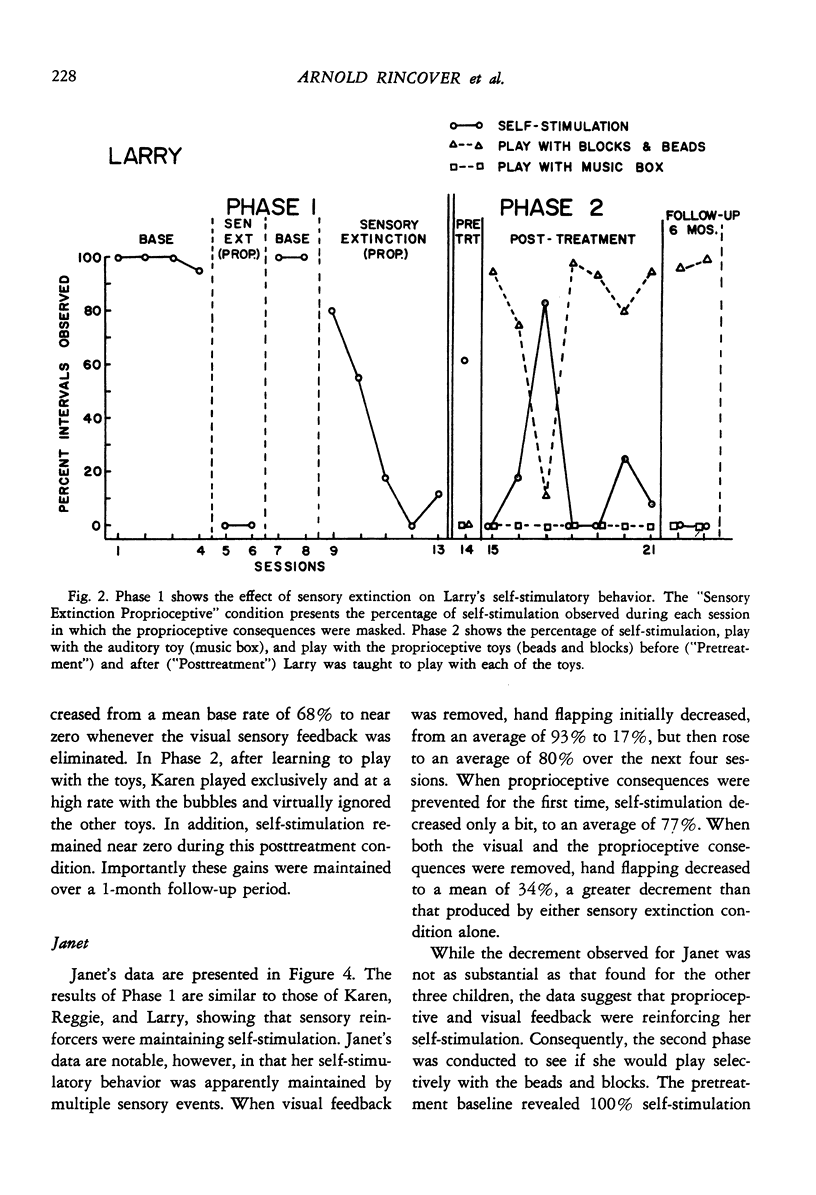
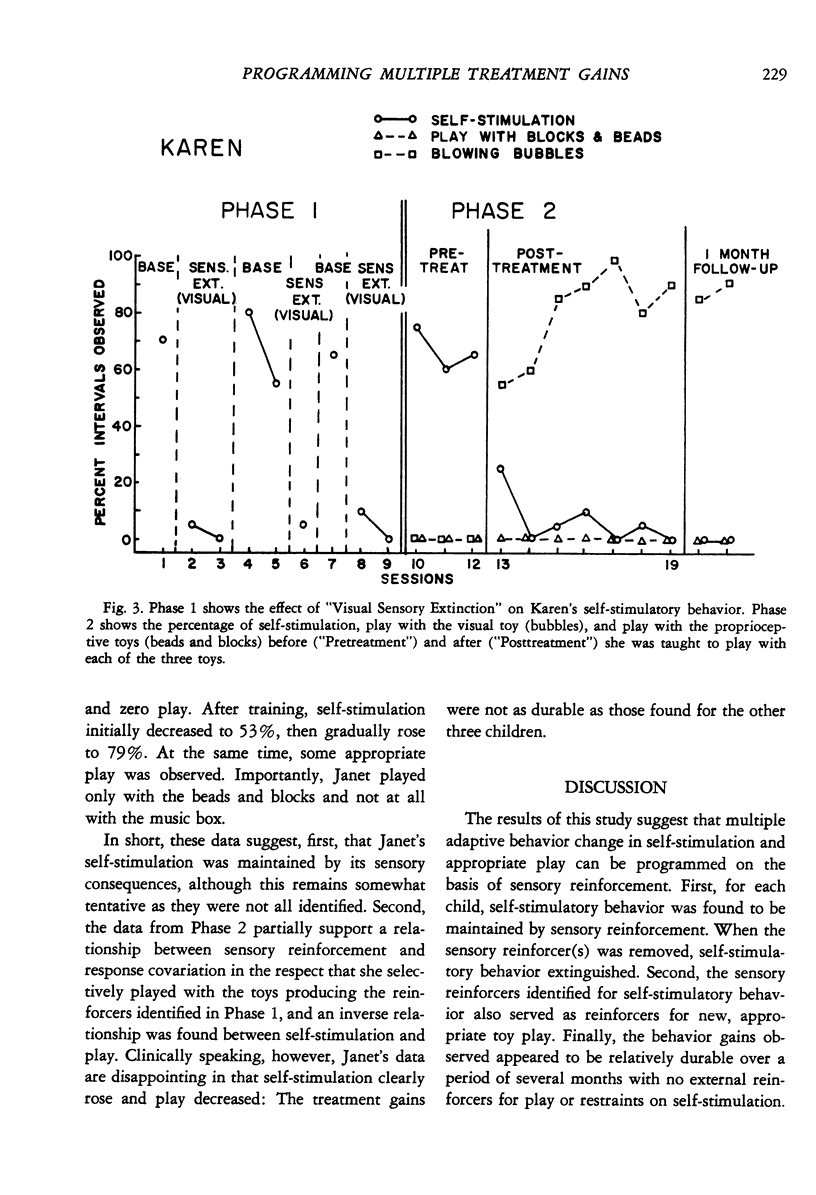

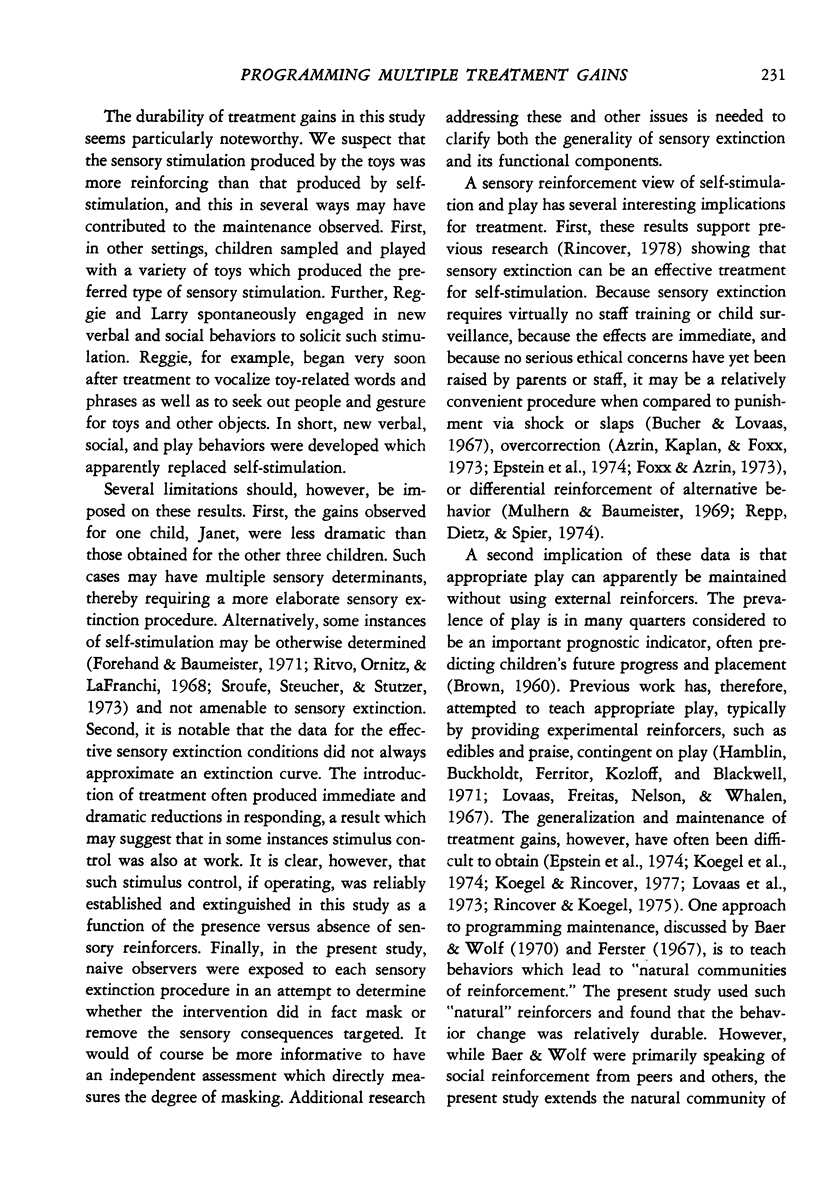
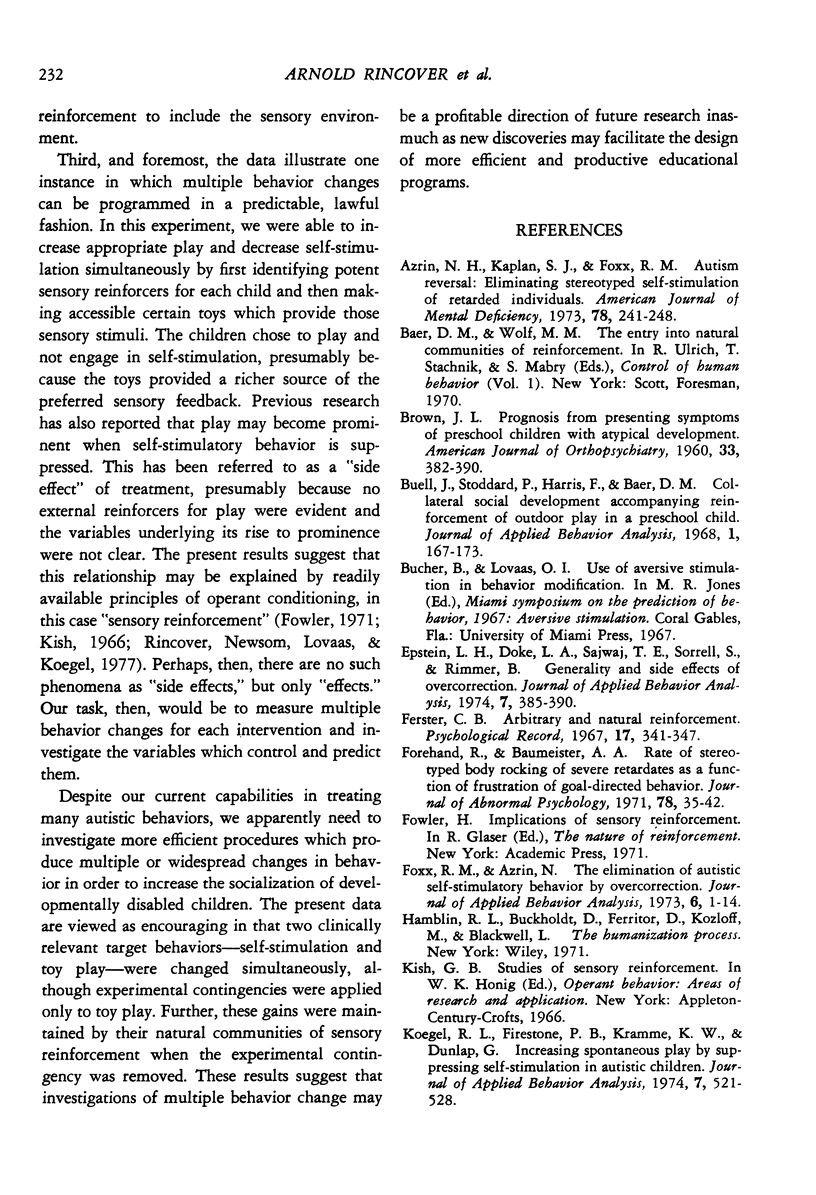
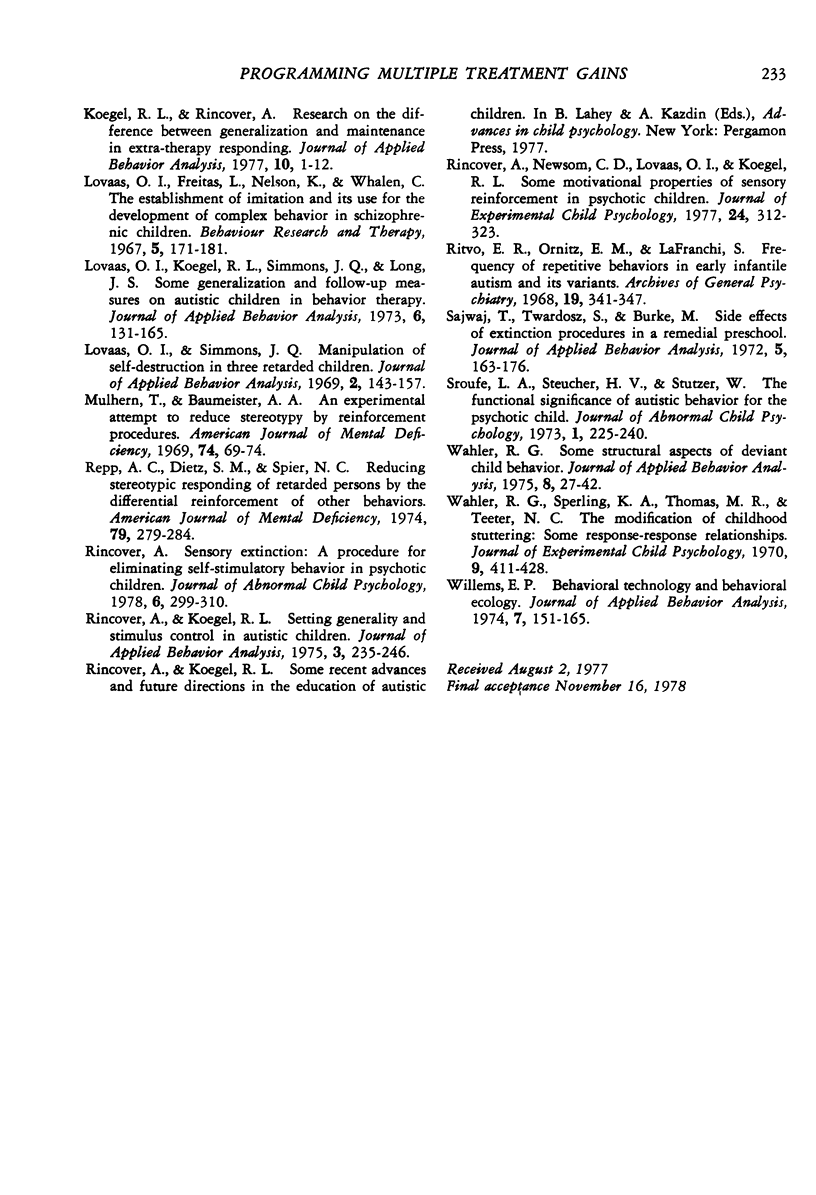
Selected References
These references are in PubMed. This may not be the complete list of references from this article.
- Azrin N. H., Kaplan S. J., Foxx R. M. Autism reversal: eliminating stereotyped self-stimulation of retarded individuals. Am J Ment Defic. 1973 Nov;78(3):241–248. [PubMed] [Google Scholar]
- BROWN J. L. Prognosis from presenting symptoms of preschool children with atypical development. Am J Orthopsychiatry. 1960 Apr;30:382–390. doi: 10.1111/j.1939-0025.1960.tb02349.x. [DOI] [PubMed] [Google Scholar]
- Buell J. Collateral social development accompanying reinforcement of outdoor play in a preschool child. J Appl Behav Anal. 1968 Summer;1(2):167–173. doi: 10.1901/jaba.1968.1-167. [DOI] [PMC free article] [PubMed] [Google Scholar]
- Epstein L. H., Doke L. A., Sajwaj T. E., Sorrell S., Rimmer B. Generality and side effects of overcorrection. J Appl Behav Anal. 1974 Fall;7(3):385–390. doi: 10.1901/jaba.1974.7-385. [DOI] [PMC free article] [PubMed] [Google Scholar]
- Forehand R., Baumeister A. A. Rate of stereotyped body rocking of severe retardates as a function of frustration of goal-directed behavior. J Abnorm Psychol. 1971 Aug;78(1):35–42. doi: 10.1037/h0031496. [DOI] [PubMed] [Google Scholar]
- Foxx R. M., Azrin N. H. The elimination of autistic self-stimulatory behavior by overcorrection. J Appl Behav Anal. 1973 Spring;6(1):1–14. doi: 10.1901/jaba.1973.6-1. [DOI] [PMC free article] [PubMed] [Google Scholar]
- Koegel R. L., Firestone P. B., Kramme K. W., Dunlap G. Increasing spontaneous play by suppressing self-stimulation in autistic children. J Appl Behav Anal. 1974 Winter;7(4):521–528. doi: 10.1901/jaba.1974.7-521. [DOI] [PMC free article] [PubMed] [Google Scholar]
- Koegel R. L., Rincover A. Research on the difference between generalization and maintenance in extra-therapy responding. J Appl Behav Anal. 1977 Spring;10(1):1–12. doi: 10.1901/jaba.1977.10-1. [DOI] [PMC free article] [PubMed] [Google Scholar]
- Lovaas O. I., Freitas L., Nelson K., Whalen C. The establishment of imitation and its use for the development of complex behavior in schizophrenic children. Behav Res Ther. 1967 Aug;5(3):171–181. doi: 10.1016/0005-7967(67)90032-0. [DOI] [PubMed] [Google Scholar]
- Lovaas O. I., Koegel R., Simmons J. Q., Long J. S. Some generalization and follow-up measures on autistic children in behavior therapy. J Appl Behav Anal. 1973 Spring;6(1):131–165. doi: 10.1901/jaba.1973.6-131. [DOI] [PMC free article] [PubMed] [Google Scholar]
- Lovaas O. I., Simmons J. Q. Manipulation of self-destruction in three retarded children. J Appl Behav Anal. 1969 Fall;2(3):143–157. doi: 10.1901/jaba.1969.2-143. [DOI] [PMC free article] [PubMed] [Google Scholar]
- Mulhern T., Baumeister A. A. An experimental attempt to reduce stereotypy by reinforcement procedures. Am J Ment Defic. 1969 Jul;74(1):69–74. [PubMed] [Google Scholar]
- Rincover A., Koegel R. L. Setting generality and stimulus control in autistic children. J Appl Behav Anal. 1975 Fall;8(3):235–246. doi: 10.1901/jaba.1975.8-235. [DOI] [PMC free article] [PubMed] [Google Scholar]
- Rincover A., Newsom C. D., Lovaas O. I., Koegel R. L. Some motivational properties of sensory stimulation in psychotic children. J Exp Child Psychol. 1977 Oct;24(2):312–323. doi: 10.1016/0022-0965(77)90009-1. [DOI] [PubMed] [Google Scholar]
- Rincover A. Sensory extinction: a procedure form eliminating self-stimulatory behavior in developmentally disabled children. J Abnorm Child Psychol. 1978 Sep;6(3):299–310. doi: 10.1007/BF00924733. [DOI] [PubMed] [Google Scholar]
- Ritvo E. R., Ornitz E. M., La Fanchi S. Frequency of repetitive behaviors in early infantile autism and its variants. Arch Gen Psychiatry. 1968 Sep;19(3):341–347. doi: 10.1001/archpsyc.1968.01740090085008. [DOI] [PubMed] [Google Scholar]
- Sajwaj T., Twardosz S., Burke M. Side effects of extinction procedures in a remedial preschool. J Appl Behav Anal. 1972 Summer;5(2):163–175. doi: 10.1901/jaba.1972.5-163. [DOI] [PMC free article] [PubMed] [Google Scholar]
- Wahler R. G. Some structural aspects of deviant child behavior. J Appl Behav Anal. 1975 Spring;8(1):27–42. doi: 10.1901/jaba.1975.8-27. [DOI] [PMC free article] [PubMed] [Google Scholar]
- Wahler R. G., Sperling K. A., Thomas M. R., Teeter N. C., Luper H. L. The modification of childhood stuttering: some response-response relationships. J Exp Child Psychol. 1970 Jun;9(3):411–428. doi: 10.1016/0022-0965(70)90028-7. [DOI] [PubMed] [Google Scholar]
- Willems E. P. Behavioral technology and behavioral ecology. J Appl Behav Anal. 1974 Spring;7(1):151–165. doi: 10.1901/jaba.1974.7-151. [DOI] [PMC free article] [PubMed] [Google Scholar]


